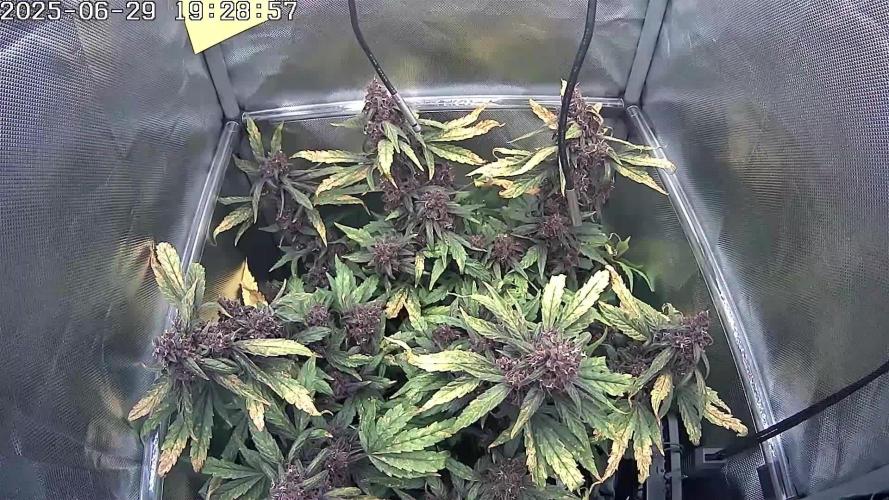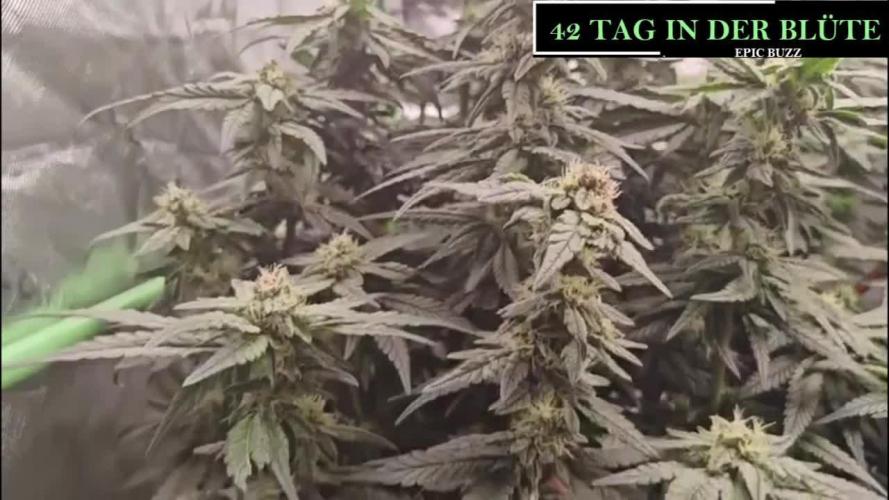The Grow Awards 2026 🏆 































Likes
Comments
Share


@Ultraviolet
Follow
When lightning strikes, it tears apart the bond in airborne nitrogen molecules. Those free nitrogen atoms N2 nitrites then have the chance to combine with oxygen molecules to form a compound called nitrates N3. Once formed, the nitrates are carried down to the ground becoming usable by organisms. Will it react with the oxygen in the air spontaneously, the answer is no. The mixture is chemically stable indefinitely. A mixture with air near the release point can be ignited, but if this does not happen then when its concentration gets below 4% it will be unable to carry a flame.
A nitrite (NO2) is a nitrogen atom bonded to only two nitrogen atoms. Very strong bond.
A nitrate (NO3) is a nitrogen atom bonded to three oxygen atoms. Weaker bond
Likes
5
Share


@Hydroponicfarm7
Follow
Se me descalabro el medidor de ec, otro dwc que estaba a más de 3 de ec . Calibre el medidor y solucione el problema.
Likes
11
Share


@BruceBlack
Follow
This week they started show va lot of yellow leaves, I was addind some more nutrients since I Think they can still fatten a bit more.
On some of them you can see there are some crunchy leaves , which bothers me a bit.. is it normal?
One of them is not drinking that much water lately so I'm just feeding it with water, hopefully I can harvest it within a week a or less, the rest of them are still drinking a lot so I'll keep feeding them with nutrients but with only 2ml/ Lt
Smell is super strong and even with the carbon filter the whole room smells like poison, hahaha, luckily i the rest of the house smell it's barely noticeable
Looking forward to harvest and finish everything, this last period is has been the toughest cuz I need to know when exactly to start the root wash
Likes
4
Share


@Dylannthoo
Follow
Day 70: Want to know how the trichomes are looking on my OG Kush, they look pretty clear to me but not 100%🤷♂️🏼 any feedback would be great, this OG is about 10 weeks old from seed, there was some temp issues, and nutrients locks but still going strong I believe.
Likes
12
Share


@chrisss
Follow
Heating Mat to keep temp in 80’s
Day15)( Week 3 Day1) No water,good Added Mushie Man
Day 16) idk if I’m right but growth seems a lil slow hopefully nothings wrong
Day 18) Added c02 yesterday night , gonna put the lights at 50 watts
Day19) Feeding stronger, keep bringing light up more as the plant grows so it’s 30 inches above the plant
Day20) GROWTH IS AMAZING , idk if it’s the co2 or it’s just getting older, prolly both either way it’s great news, moving light up more, I’ll start LST on Sunday which is day 22, cleaning fan cause of humidifier ( tap water), keep humidity in high 50s and temp above 80 , for humidity reasons I only turn on in-line fan for a couple hours some afternoons
Day 21) Fed Calmag, grow and micro to tap water(PH 6.2), added more coco to the top,will LST tmrw
Likes
149
Share


@CBD_Sweden
Follow
Hi all the happy people here in GrowDiaries.
This is my second cultivation ever and it will be fun to try a bigger space than my closet grow.
First, I'm just going to say I'm done with the construction of my new growroom.
I put some pictures on the construction here in week one.
The room is 2.14 meters by 1.7 meters and has a ceiling height of 2 meters.
It provides a floor area of 3.6 square meters.
I use a 54 Watt Lightwawe T5 for germination and 2 Pcs 400 Watt HPS lamps.
I have a channel fan that replaces the room air about 40 times an hour to get a comfortable theme in the room, the air enters a fresh air intake from the outside.
The air is purified through a carbon filter to then leave the room to the rest of the basement.
Then I use that heat to heat the rest of the basement.
I will use 8 pcs 15 liter Autopots to grow with and a 100 liter water tank that supplies the pots of water and nutrition.
I will grow completely organically in soil and will watercure my buds to get the best possible medicine for me.
But there are no cultivation rooms to be displayed here, so I continue with what is most important.
Today I have put my seeds in my moisture dome and hope the seeds have germinated within a few days.
I am very excited to see how the new growroom will work and how this Blue cheese Auto from Royal queen seeds will turn out.
Blue Cheese automatic cannabis seeds are a cross of Blueberry Automatic and Cheese Automatic that has been perfected over five years of breeding and careful selection. The result is a feminized, autoflowering strain with superior yield, flavor, and effects to either of its distinguished parent strains.
THC: 16%
CBD: Low
Yield Indoor : 325 - 375 gr/m2
Yield Outdoor: 60 - 110 gr/plant
Height Indoor: 40 - 70 cm
Height Outdoor: 60 - 110 cm
Flowering: 7 - 8 weeks
Harvest month: 9-10 weeks after planting
Genetic Background: Blueberry x Cheese x Ruderalis
Type: Sa 35% In 40% Ru 25%
Effect: Cerebral and uplifting
Climate: Mild
..............................................................................................................................................................................................................................................................................................................................................
Update 2017-08-15. All 4 seeds have germinated and planted in small pots inside the humidity dome.
I'm so glad it worked so well and now it's just hoping they'll start growing and become 4 big healthy girls :)
...............................................................................................................................................................................................................................................................................................................................................
Update 2017-08-16. I have mixed my own soil today. Its 40% sieved peat harrow H2-H4 0-30 mm, 45% sieved peat harrow H4-H6 0-30 mm. 5% sand and 10% of compost soil. And i use 15% of perilite and mix it all together.
................................................................................................................................................................................................................................................................................................................................................
Update 2017-08.20. Nr1 and 2 grow and thrive.
Number 3 just got rid of the seedpod and is folding out the sheets.
Number 4 is a bit shy and can only be seen if you look carefully into the soil.
.........................................................................................................................................................................................................................................................................................................................................
Update 2017-08-21. Nr 1 and 2 is doing well. Nr3 is trying to catch up and Nr4 is still shy.
--------------------------------------------------------------------------------------------------------------------------------------------------------------------------------------------------------
2017-08-23. Transplanted 2 girls from humidity dome and the small germinating pots to 15 liter autopots. The other 2 girls have to wait a little more before transplant to the autopots.
................................................................................................................................................................................................................................................................................................................................................................................
2017-08-27. The girls have settled in to there new home of the 15 liters autopot after a little transplant chock. Now the real week 1 starts for me and the girls.
--------------------------------------------------------------------------------------------------------------------------------------------------------------------------------------------------------
2017-08-28. New pic and movies.
---------------------------------------------------------------------------------------------------------------------------------------------------------------------------------------
2017-08-28. Nr3 is transplanted in 15 liter autopot.
-------------------------------------------------------------------------------------------------------------------------------------------------------------------------------
2017-08-29. New movie of the girls. Its no water for 3 days now for Nr1 and 2 so the roots develop more and match the plant above the soil. The temp controlled fan is awesome, its easy to set what temp you like to have in the room. Right now its 28 celcius. And humidity is 56%.
------------------------------------------------------------------------------------------------------------------------------------------------------------------------------------------
2017-08-29.
Hello to you who read my diary, I just want to say that I am pleased that you have chosen to check in with me and in my diary.
I just want to say that I do this for myself and for a steady flow of my medicine.
Everything you read and see in my diary is 100% honest and I will never distort or beautify anything here.
I document my crops so that I can learn from my mistakes and also to look back at those different crops.
I try to update with pictures every day and with text if something special has happened in the garden.
This is my strainhunt for the best medicine and the beginning of my journey with cannabis and the cultivation of it.
-----------------------------------------------------------------------------------------------------------------------------------------------------------------------
2017-08-30. Cleaned the room this morning, just vacuuming and cleaning with chlorine solution. Im testing the fan to control temp and humidity, it works great.
Added some pics with measurements and movie. Everything is looking great right now.
---------------------------------------------------------------------------------------------------------------------------------------------------------------------------
2017-08-31. New pics and videos.
---------------------------------------------------------------------------------------------------------------------------------------------------------------------------------
2017-09-01. New pics and videos. Gave each of the girls with 2 ml Alg-A-Mic, 4ml Bio-Grow, 4ml Bio-Heaven and 10 ml Formulex mixed in 2 liters of water.
I hope they like it :)
-------------------------------------------------------------------------------------------------------------------------------------------------------------------------------------------------------------------------------------------
2017-09-02. New pics and the girls liked the water and nutrients yesterday.
-------------------------------------------------------------------------------------------------------------
2017-09-03. New videos of the girls this morning. Nr1 and 3 looks great and nr 2 is looking a little funny, maby a little stressed.
Kl. 16.00. Did some defoliation on the girls. Added video.
Kl.. 23.00. New videos, defoliation and leaftucking.
-----------------------------------------------------------------------------------------------------------------
2017-09-04. Kl. 11.00. Week 3 starts. Trying to LST the girls and defoliate/leaftuck. New picks.
KL 23.00. New video.
--------------------------------------------------------------------------------------------------------------
2017-09-05. KL 08.00. Cleaned the room this morning, just vacuuming and cleaning with chlorine solution.
KL 12.00. The girls got 2 liters of water each with nutes in it, added a video.
----------------------------------------------------------------------------------------------------------------
2017-09-06. KL 08.00. The girls woke up after their beauty sleep, the leaves are always a bit down after 6 h of darkness, but they will stretch now when the HPS lamp starts.
Everything looks good and I keep trying to tuck the leaves so they get the maximum amount of light where needed. Added pics and video.
The Nr 3 girl is still a little bit behind the other 2 girls and all the 3 girls look like there 3 different pheno of the same plant.
KL 23.30. Did some LST.
----------------------------------------------------------------------------------------------------------------------
2017-09-07. Day 21 from sprouting, Nr3 is 17 days from sprouting. I have never tested PH in my grows, when growing organic in soil iv learned that it adapt PH by it self. But im curious by nature so i had to test.
Kl 10.00 Tested PH in the soil, it was 6.9 and tested my tap water and it was 6.8. Added a video of the girls, its 10 H after defoliation, LST and leaftucking. I think its looking good.
Kl 22.30. New pics.
Likes
44
Share


@Chedderbob112
Follow
Just flipped everything is growing like mad all the revegged monster cropped clones n that had been in flower n now hav fresh growth am buzzin will need to go in n defoliate a bit lolly pop and clean it up a bit bit yeah oh yeah chedder does it well @chedderbob112 @s2340420
Likes
19
Share


@AlpenZilla
Follow
Harvest – Day 66 (BT42 / July 3rd)
✂️ Today was the day – RedPure#4 was harvested!
📅 Right on schedule at BT42, just as the breeder described.
⚖️ Wet weight: 454 g
Now it’s time to dry and hope I can beat the 50 g dry weight from the last run 😎
Fingers crossed! 🤞💨
Likes
17
Share


@gottagrowsometime
Follow
9/2/25
Overall I'm delighted with these. 17 weeks grows for me are few & far between. These 2 phenos had 7 weeks in 2L pots. And were put into a 20L pot of coco/pebbles and gives 10-14 days to recover and were flipped. I purposely grew them this shape as I had to make sure I kept them apart if hit with WPM or anything like that. As grows these long, buds this dense. And running a tent with a bunch of mixed grows from done to days into the start of the 12-12 flip.
I would have liked to run for another week on a 100w light and high doses of UV but because of such a mixed bag of grows in my tents. Running reds/uv just wasn't even attempted.
10/2
She smells absolutely amazing, buds are super big, sticky & very smelly. They're still mainly hard for the moment. And leaves not even limp. So, I removed the big fan leaves to allow air to move around better. They're hanging behind my 100cm2 tent kept out of UV rays.
Likes
11
Share


@StartGrowingShxt
Follow
Week 15
May 21
-ladies are still swelling all but the grapefruit pheno but she is frostier than the rest so good with the bad I guess hopefully she just takes longer to finish
-just been ferments with recharge mostly and been doing well alternating between top and bottom watering and watering every other day
-light burn and possible calcium deficiency on one plant but she’s the chunkiest girl and might finish before the rest
-smooth sailing other than that
Likes
51
Share


@DogDoctorOfficial
Follow
An in to soil she and her sister testers go, i know that for know everything looks the same , apart from the photos, but this will start changing with them growing. For now all of them are growing pretty much the same and now that they move in to soil and start feedings they will start showing the phenotype and genetic differences, but for now all looking great , healthy and strong af!!!
Haded a intro video from seed in to now, including how i transplant and what i use wen doing it so, and from here the moon is no limit for this babes i believe , so stay tuned as this testers they promise to be a interesting ride <3 <3 <3
They grew amazing for only a week fast and vigorous, all the testers for now look very the same <3 <3 <3
As always thank you all for stoping by and for supporting me on this journey, i am super passion about growing and fell blessed to have you all with me on this new journey <3 <3 <3
Genetics - Fast Buds Tester 08 09 10 11
Ligth - LUMATEK ZEUS 465 COMPACT PRO
Food - APTUS HOLLAND
#aptus #aptusplanttech #aptusgang #aptusfamily #aptustrueplantscience #inbalancewithnature #trueplantscience #fastbuds #dogdoctorofficial #growerslove
With true love comes happiness <3 <3 <3 Always believe in your self and always do things expecting nothing and with an open heart , be a giver and the universe will give back to you in ways you could not even imagine so <3 <3 <3
All info and full product details can be find in can find @
https://2fast4buds.com/ wen released
https://aptus-holland.com/
https://autopot.co.uk/
https://lumatek-lighting.com/
<3 <3 <3 Growers love to you all <3 <3 <3
Likes
5
Share


@Grower_Boris
Follow
🌿 Grow 🤝 Freunde 🌱
Update – Tag 42 in der Blüte
Die Lady’s stehen jetzt seit 42 Tagen in der Blüte und entwickeln sich richtig stark: Die Buds sind deutlich verdickt, tragen schon ordentlich Harz und das Canopy ist schön gleichmäßig geschlossen. Die Blätter zeigen ein sattes Grün mit leichten Sugar-Leaves um die Buds herum – genau das Bild, das man sich in der mittleren bis späten Blütephase wünscht. Beim Öffnen des Zeltes kommt einem inzwischen ein leichter süßlicher Duft entgegen, der von Tag zu Tag intensiver wird – sehr vielversprechend für das spätere Aroma. 🌸😋
Die Struktur der Pflanzen ist schön aufgedehnt, viele Blütenstände sitzen im optimalen Lichtbereich und auch die tieferen Etagen bekommen noch genug Power von der Farmlite-LED. Insgesamt machen alle Pflanzen einen vitalen, stabilen Eindruck – der Endspurt in Richtung Reife kann kommen. 🚀🌱
📹 Das aktuelle Video zeigt die Bud-Entwicklung und das voll ausgefüllte Zelt nochmal im Rundumblick – perfekt, um den Fortschritt seit Beginn der Blüte zu sehen.
Setup-Details:
Beleuchtung: Farmlite LED, ca. 20 cm Abstand, 12/12 Lichtzyklus
Topfgröße: 20 L DWC
Nährstoffe: Hy-Pro Hydro A/B 5ml7liter l, Epic Boost 0,5ml/Liter Generator 0,15/Liter
Wasserwerte: pH 5,9, Lösung 20 °C
Klima: 28 °C Tag / 16 °C Nacht, 60% RLF
Pflanzen: aus Samen, aktuell ca. 94 cm hoch
Alle Updates, Werte und weitere Bilder gibt’s wie immer im Tagebuch: https://growdiaries.com/diaries/288056-grow-journal-by-growerboris
Sponsoren & Rabattaktionen 💚
Ein großes Dankeschön an meine Sponsoren:
Thomas Benedikt - Green Growery - Hy-Pro Fertilizers - Farmlite Grow Light
Bei Green Growery bekommt ihr als Erstbesteller satte 20% Rabatt und kostenlosen Versand mit dem Code GrowFreunde20. Für jede weitere Bestellung gibt es mit GrowFreunde10 noch 10% Rabatt auf das gesamte Sortiment. 🌿💸
#growfreunde #DWC #blütephase #hydropower #greenlovers #budporn #cannabiscommunity
Likes
15
Share


@valiotoro
Follow
Hello everyone😎
Week 5 of flower for the LCC🍋🍒🍪
It’s almost the end!
One more week for the top buds to be ready✂️
The smell is amazing lemon zest & rippen cherry super sweet🤤
One more feeding with Green Sensation etc then flush.
Likes
41
Share


@Ganjagrandaddy
Follow
Day 42 Flowering: Hi all. Here we are past the halfway point and close to seeing some finished Fast Buds nugs. They have been starting to brown off the 1st pistols on most of the colas but the Six Shooter both look like they will be finished 1st. With the different growing styles used on them leading to different structures, it will be interesting to see which yields the most. The #2 has lots of nice forming shaggy looking tops and the #1 has more natural long colas.
The Mexican airline are similar to each other but # 1 is less advanced into flower I think. They have browning pistils but the # 2 is way chunkier and.developed .
What can I sat about rhe Strawberry pie that the video doesn't show ?. Wow this strain is a nice grower. The buds are nice and large with a fresh appeal to them even as they ripen. They are a 9 week (63 days) flowering strain so with so long to keep fattening and developing , I can only imagine their bounty of colas to come very soon. Well done fast buds
The fc3000 is doing a brilliant job and hasn't skipped a beat so far. The canopy has been so uneven and hard to please the needs usually but this has not held anything back now. The penetration is excellent and has helped develop some amazing buds not in direct light too. Roll on harvesting these amazing plants. Be safe and well growmies
Likes
14
Share


@iLoveGoodWeed
Follow
She had some samll defolation done and one more will be done this week. She should start getting tall next week.
Likes
50
Share


@Huggomadd
Follow
💪💚♨️💪💚♨️💪💚♨️💪💚♨️💪💚♨️💪
Just gave her a couple more flushes this week to finish off this Beastly Banner.
Bruce didn't give them colors I wanted off her but still has the looks and that sweet aroma maintained.
Her trichomes really clouded up fast within this last week. Bruce Banner Fast does have a very few amber trichs as well which is perfectly fine with my liking.
**She'll be going dark on the 18th for 36-48hrs. before her harvest. As usual, I also remove the top couple inches of 'loose' soil to help aid her in the drying process.
💚💪♨️💚💪♨️💚💪♨️💚💪♨️💚💪♨️💚
Oozing with plenty of resinous and bulbous flowers, this bulky Hulk is ready and prime.
👉Rock on to all showing the love! Keep them gardens growing spectacular.
Until Bruce's harvest.
Stay frosty🥂
Hugo'
💚💪💪💚💪💪💚💪💪💚💪💪💚💪💪💚






















